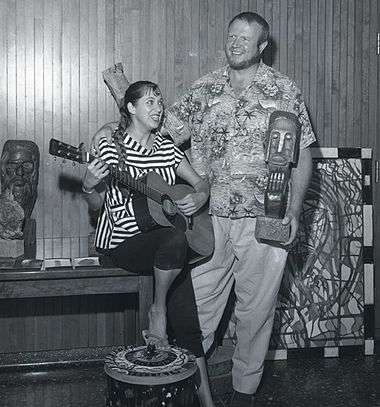Eric "Big Daddy" Nord
Eric Nord (1919–1989), also known as Eric "Big Daddy" Nord, was a Beat Generation-era nightclub owner, poet, actor, and hipster. Newspaper columnist Herb Caen called him the "king of the Beat Generation." Corpulent, standing 6 feet 7 inches tall, Nord was the face of the Beat generation to San Francisco and Los Angeles newspaper readers in the late 1950s and the founder of the hungry i nightclub.

Nord was born Harry Helmuth Pastor in Krefeld, Germany to Dorothea, an American, and Carl Theodore Pastor, a German. As a child, he often accompanied his father on business trips to the United States. His parents divorced in 1920, and when he was 19, he left Germany in 1938. He studied acting in Los Angeles and took the stage name of Eric Nord. In 1942 or 1943, shortly after his arrival in San Francisco, he met and married Mary Hollister with whom he had three or four children, including Carl Paul Pastor. However, Mary left him within a few years.
In the early 1950s, Nord sometimes worked at the Co-Existence Bagel Shop (the self-described "Gateway to Beatnik Land"), a popular hangout in North Beach. (in Bagel Shop Jazz, the poet Bob Kaufman called its patrons "...shadow people...mulberry-eyed girls in black stockings, smelling vaguely of mint jelly…turtle neck angel guys..."). In 1950, Nord rented a basement in North beach where he and a growing number of young people, aspiring beatniks, hung out. He called the place the "hungry i" nightclub. Enrico Banducci later took over club and it became the cradle of stand-up comedy.
In June 1958, on orders from San Francisco mayor George Christopher to crack down on drug use and delinquency in North Beach, San Francisco police raided Nord's Party Pad club and arrested him for operating a public dance without a license. Later that summer, on August 8, in an article titled "Schoolgirl Lost in Beatnik Land", San Francisco Chronicle readers learned that two high school girls in Eric "Big Daddy" Nord's production of Archy and Mehitabel had disappeared after the previous night's performance. Chronicle readers learned how Nord and another man had taken the girls on a car trip. Nord, driving his Oldsmobile at the end of a beatnik procession, saying his interest in the girls was only fatherly, turned himself in at the Hall of Justice. His much-publicized trial ended in December, when he was fined $300 and given three years' probation. Said the presiding judge, "You and your friends in Beatnikland emphasize your unusual ways to give an impression that you have talent, ability and stature, when actually a person looking into you finds no talent at all." Later, the same judge overturned his own verdict.
After his 1958 trial, Nord declared bankruptcy, moved to Venice in Southern California, and, putting his entrepreneurial ability to good use, started The Gas House, a café that soon became popular with Los Angeles beatniks and poets, who read their work alongside Nord. The Gas House was used as the setting for a cult horror film called The Hypnotic Eye (1960) that featured Nord as a bongo-playing beatnik. The role helped to launch Nord's brief film career.
In the mid-1960s, Nord returned to Northern California, where, in Scotts Valley, he converted a barn into a psychedelic night club that catered to hippies and was the scene of some of Ken Kesey's happenings. In the early 1970s, he operated a "cultural center" in San Francisco's Haight Ashbury neighborhood. In 1972 Nord appeared as the character 'God' in a San Francisco underground photo-comic titled 'SuperJesus' now rated an underground comix classic. He moved to Los Gatos in 1975 and remained there until his death in 1989.
Poetry
- As He Sees It (Lost Gatos: Free Press, 1968)
Movies
- The Flower Thief (1959)
- The Hypnotic Eye (1960)
- Once Upon a Knight (1961)
- Hungry Eye (1971)
- Steel Arena (1973)
External links
- Beatnik!, a Beat Scene Magazine article that includes descriptions of Nord's run-ins with the law in 1958
- Eric (Big Daddy) Nord; 'Beat Movement' Leader, obituary in the Los Angeles Times
- Eric Nord on IMDb
- Eric 'Big Daddy' Nord and Julie Meredith at The Gas House in 1959